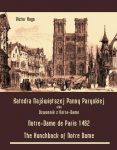...jest pusty
"Katedra Najświętszej Marii Panny w Paryżu – powieść Wiktora Hugo znana w Polsce również pod tytułem „Dzwonnik z Notre-Dame”, osadzona w czasach późnego średniowiecza. Według słów samego autora, jest to „obraz piętnastowiecznego Paryża i całego piętnastego wieku przez pryzmat tego miasta”. Osią powieści jest wątek miłosny archidiakona Klaudiusza Frollo do pięknej Cyganki Esmeraldy. Książka wydana w 1831 roku porusza nietypowe jak na tamte czasy problemy zgubnego pożądania i tolerancji. W powieści nie ma nic białego ani czarnego, są tylko odcienie szarości. Nie ma też tu jednoznacznie złej postaci, a nawet okrutne czyny Frolla można zrozumieć i budzi on współczucie, a nawet sympatię czytelnika. Książka została napisana pod wpływem odnalezienia przez autora greckiego napisu „ΑΝАΓΚΗ” („Przeznaczenie”) na ścianie Katedry Notre-Dame. (http://pl.wikipedia.org/wiki/Katedra_Marii_Panny_w_Paryżu)
Notre-Dame de Paris relève du genre du roman historique, qui est à la mode au début du XIXe siècle16, de même que la période du Moyen Âge qui suscite un intérêt nouveau de la part des écrivains et des poètes à partir des années 1820, sous l'impulsion d'auteurs comme Chateaubriand ou Madame de Staël. Le chapitre « Paris à vol d'oiseau », en particulier, présente une tentative de reconstitution historique du Paris de 1482. Mais Victor Hugo ne se considère pas comme tenu de respecter la vérité historique à tout prix et n'hésite pas à modifier le détail des faits et à resserrer l'intrigue pour faire mieux ressortir le caractère de personnages historiques comme Louis XI ou pour mettre en avant sa vision de l'Histoire. En cela, il applique à son roman les principes exposés dans un article « À propos de Walter Scott » qu'il a publié en 1823, et où il affirme : « j'aime mieux croire au roman qu'à l'histoire, parce que je préfère la vérité morale à la vérité historique ». (http://fr.wikipedia.org/wiki/Notre-Dame_de_Paris_(roman)
The novel's original French title, Notre-Dame de Paris (the formal title of the Cathedral) indicates that the Cathedral itself is the most significant aspect of the novel, both the main setting and the focus of the story's themes. With the notable exception of Phoebus and Esmeralda's meeting, almost every major event in the novel takes place within, atop, and around the outside of the cathedral, and also can be witnessed by a character standing within, atop, and around the outside of the cathedral. The Cathedral had fallen into disrepair at the time of writing, which Hugo wanted to point out. The book portrays the Gothic era as one of the extremes of architecture, passion, and religion. The theme of determinism (fate and destiny) is explored as well as revolution and social strife. The severe distinction of the social classes is shown by the relationships of Quasimodo and Esmeralda with higher-caste people in the book. Readers can also see a variety of modern themes emanating from the work including nuanced views on gender dynamics. For example, Phoebus objectifies Esmeralda as a sexual object. And, while Esmeralda is frequently cited as a paragon of purity — this is certainly how Quasimodo sees her — she is nonetheless seen to create her own objectification of the archer captain, Phoebus, that is at odds with readers' informed view of the man. (http://en.wikipedia.org/wiki/The_Hunchback_of_Notre-Dame)"
Format
mobi
Wydanie
DL-ebwm
Wydawca
Armoryka
Rok wydania
2014
Dla tego produktu nie napisano jeszcze recenzji!
Napisz recenzjęWłaściciel sklepu internetowego nie gwarantuje, że publikowane opinie pochodzą od konsumentów, którzy używali danego produktu lub go kupili.
Zobacz także:


















